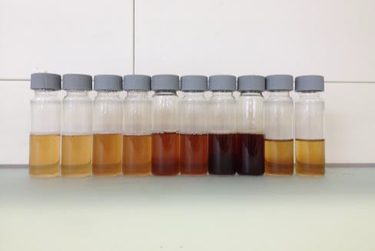Completed Short Term Scientific Missions (STSM)
printThird Grant Period (1 May 2017 - 30 April 2018)
Aleksandar Petrovski
Aleksandar Petrovski, assistant professor at the Faculty of Architecture, Ss Cyril and Methodius University in R. of Macedonia completed a Short Term Scientific Mission (STSM). He was hosted by prof. dr Jelena Ivanovic-Sekularac, at the Faculty of Architecture, University of Belgrade in Serbia. The STSM is entitled "Comparison of wooden and conventional houses sustainability: Increasing application of modified wood in Macedonia". The housing sector in Republic of Macedonia, situated in South-East Europe, is responsible for the consumption of significant amounts of energy and material resources and for the production of large amount of emissions and waste. The increased application of wood and modified wood products can substantially improve these conditions and contribute towards increasing the sustainability in the construction industry and the creation of sustainable homes.
Therefore, the aim of the STSM is to compare wooden structures versus conventional masonry and concrete elements, regarding their influence onto the buildings' energy performance and life cycle emissions. Therefore, during the STSM the simulation of four different alternatives of residential buildings in the Republic of Macedonia, evaluated in terms of energy performance and Life-Cycle Assessment (LCA) for the "cradle to gate" phase.
Model 1 is made of reinforced concrete load-bearing structure and masonry for the internal and external walls. The Model 2 is made of concrete load-bearing structure with wooden- framed internal and external walls. In Model 3 the columns and beams are made of reinforced concrete, while the slabs, internal and external walls are made of wooden framing studs, while in Model 4, the load-bearing as well as non-load bearing elements are made of wooden framing studs, Figure 1. Also, an comparison is made between two external wall types made of timber structure and finish with a Kebony and Accoya, regarding their environmental impact indicators.
The data for the materials are derived either from the manufacturers Environmental Product Declarations (EPD) or from the database ÖKOBAUDAT [2], which is compliant with the EN 15804 standard. The data from the EPD's, which are used in this research are extracted for the phase "cradle to gate" from which the embodied CO2 emissions, as well as the other pollutants defined with the standards ISO 14040 and ISO 14044, are calculated.
Hence, the indicators used in this research are: Global Warming Potential (GWP) that measures the carbon dioxide and methane emissions; Ozone Depletion Potential (ODP) that measures emissions that deplete the stratospheric ozone layer; Acidification Potential (AP) that measures emissions that cause acidifying effects to the environment; Eutrophication Potential (EP) that measures the potential impact onto undesirable shift on aquatic and terrestrial ecosystems; Photochemical Ozone Creation Potential (POCP) - Smog, measures the emissions of precursors that contribute to the formation of ground level smog; Abiotic Depletion Potential (ADP) describes the consumption of non-renewable resources, which are described separately for the depletion of mineral resource elements (ADPE)and non- renewable fossil energy resources (ADPF).
The bill of quantities of the aterials are obtained from the design office [1], of the housing building and is used for calculating the t tal emissions in the phase "cradle to gate". The biogenic carbon embodied in the product is considered as a CO2 reduction or a “negative emission. For the Kebony wood the biogenic carbon uptake is derived from the products EPD which is estimated according to NS-EN 16449:2014. The mass of the green wood is 480 kg/m3, 1,17 m3 of green wood is used for every m3 of Kebony Radiata, and the moisture content is assumed to be 12% as recommended by the standard. The biogenic carbon uptake is thus 919,29 kg CO2. The EPD declaration of the Accoya states that the carbon sequestration has been taken into account of the finished product: 1.85 kg CO2 per kg Accoya wood (corresponding to 944 kg CO2 per m3 Radiata pine, 999 kg CO2 per m3 Scots pine and 1397 kg CO2 per m3 Beech).
The heat transmission coefficients of the elements are calculated according to the Macedonian harmonized standards MKS EN ISO 6946 and MKS EN ISO 13370 and they comply with the prescribed values for each of the construct on elements, [3]. The energy performance of the described models is completed by using the EnergyPlus energy Simulation software [4], and the final energy demand has been calculated. The data used for model calculation is design climate data for the city of Skopje and typical meteorological year (TMY) for conducting dynamic simulations (buildings dynamic behavior study). The aggregated "cradle to gate" EPD data for each construction element, such as: external wall, internal wall, roof and floor are calculated in Excel. The results of the study revealed that by replacing conventional concrete and masonry constructions with wooden constructions in low-rise family houses, the carbon emissions can be reduced up to 145%. The results give significant insight on the influence that the different construction mater also have on the environment and buildings performance. Also, the research enables stimulation of the construction industry in utilizing wooden structures as well as modified wood products, and proposes promulgating legislation that could increase their use. These actions would provide means for the development of sustainable buildings, neighborhoods and sustainable development of the Republic of Macedonia.
[1] “mdc.Architectonica,” 2018. [Online]. Available: http://www.arh.com.mk/page.php?page=0. [Accessed: 09-Jun-2018]. [2] “ÖKOBAUDAT.” [Online]. Available: http://www.oekobaudat.de/. [Accessed: 09-Jun-2018]. [3] “Rulebook on energy efficiency,” Official Gazette of R. of Macedonia, vol. 94, no. 13, 2013. [4] “EnergyPlus | EnergyPlus.” [Online]. Available: https://energyplus.net/. [Accessed: 18-Jun-2018].
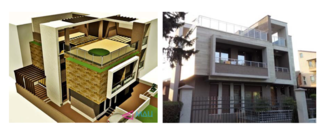
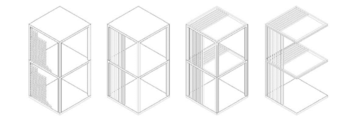
Figure 1. Typology of the analysed models
a) Reference model [1]
b) Diagram of the four combinations of different materials for the construction element
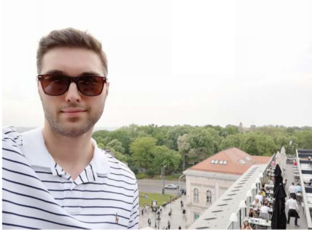
Figure 2. Picture of the STSM researcher with a Belgrade scenery
Carmen-Mihaela Popescu
Dr Carmen-Mihaela Popescu is a researcher at Petru Poni Institute of Macromolecular Chemistry, Romania. She completed her Short Term Scientific Mission (STSM) at Aalto University during March 25-31, 2018. The purpose of the STSM was to investigate a series of chemically modified Scots pine sapwood with different anhydrides, in order to determine the degree of penetration of the chemicals in the wood cell wall by using the Raman imaging technique and chemometric methods (e.g. Principal component analysis – PCA). It is known that during the chemical modification, wood undergoes transformations depending on the anhydride used, the applied parameters, and depending on the material properties. Even this method is not a new approach, there are aspects which are not elucidated, therefore a better understanding of these transformations is needed.
The STSM enabled Dr Popescu to get knowledge on the Raman imaging technique, and it was highly useful in creating connections and new collaboration with Prof. Lauri Rautkari from Aalto University.
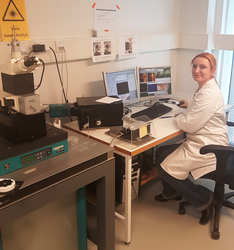
Lea Bächle
Lea Bächle, master student at University of Göttingen, Germany was hosted by Prof. Dr. Miha Humar at the Biotechnical Faculty of University of Ljubljana, Slovenia in April 2018. During the STSM, she performed Tensiometric Measurements to determine the Capillary Water Uptake and Contact Angle of DMDHEU modified and copper-based wood preservative treated specimens. The data will contribute to her thesis project on the material resistance and moisture performance of chemically modified wood. In this study different wood species and treatment concentrations were examined regarding the material’s resistance against fungal decay and ability to absorb and release water.
Using a performance prediction model described by Meyer-Veltrup et al. (2017) a predicted decay rate is calculated based on the laboratory tests conducted at the University of Göttingen and Ljubljana University. Further, the data of fungal decay examinations (CEN/TS 15083) will be used to conduct first preliminary systematic and dose-related durability classification for chemically treated wood, as allowed since the newest revision of EN 350 (2016).
The STSM enabled the exchange of knowledge and research experience. Thanks to the laboratory facilities of University of Ljubljana it was possible to carry out experiments which could not have been conducted at the University of Göttingen. Furthermore, the expertise of the hosting lab group was a great help for analysis and interpretation of the obtained data.
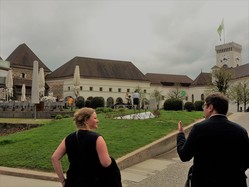
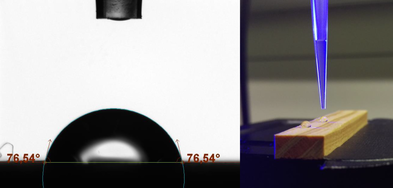
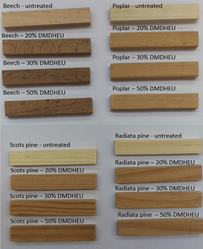
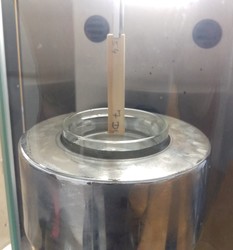
Claude Feldman
Claude Feldman, Pambou Nziengui is a doctoral student at Clermont Auvergne University (UCA-IP) completed his Short-Term Scientific Mission (STSM) at the University of Florence with Dr. Giacomo Goli. Wood under stress and relative humidity variation presents a complex behavior called mechano-sorptive behavior. So one of the objectives of my doctoral thesis is to study the mechanical behavior of wood beams under the combined actions of climatic variations (moisture and temperature variations) coupled with a long term load (creep tests, mechano-sorptive effects) and the spread of cracks until the failure of the beams. To reach this objective, three European species (beams of Populus Alba, Abies Alba Mill and Pseudotsuga Menziesii) and three equatorial species (beams of Milicia Excelsa, Aucoumea Klaineana Pierre and Guibourtia tessmannii) have been selected and are loaded in creep test (4-points bending test) in outdoor conditions.
In this STSM the aim is to enlarge our knowledge in terms of long time behavior under load of thermally modified wood. The main purpose is, on the basis of the experimental data obtained, to develop and verify mathematical simulation models for unmodified and thermally modified wood samples within a small scale experiment. The experimental device is a climate regulated small chamber inside a larger climatic chamber. The test have been done in 3 point bending configuration. Viscous behavior was measured as first and climbing (+20% RH) and falling (-10% RH) relative humidity cycles were applied after a first simple creep period. This STSM allowed to collect real creep and mechano-sorptive data on real small scale beams in order to test the mathematical models developed by our team in my laboratory Institut Pascal (IP) at Clermont-Ferrand and to verify the possibility to apply the same models to thermally modified wood. At GESAAF unmodified and thermally modified Poplar wood were tested as well as unmodified Silver Fir, Douglas fir, Okoumé and Padouk woods. This STSM was also the opportunity to open collaboration on the structural wood axe with the colleagues of GESAAF of the University of Florence. The results obtained on this STSM are very high quality measures and we will proceed in a short time to apply our models and to result in a scientific publication where the FP1407 action will be acknowledged.
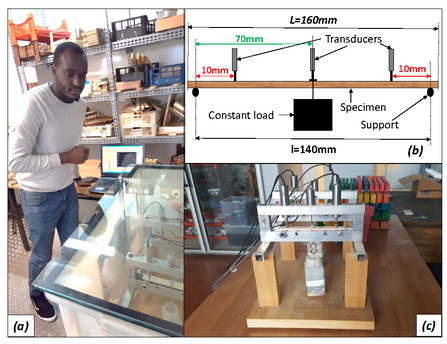
Figure: Following of the evolution of the mechano-sorptive tests for unmodified and thermally modified woods in the climatic chamber of GESAAF (University of Florence) by Claude Feldman Pambou Nziengui (a) ; experimental setup (b) and (c).
Marcin Brzezicki
Marcin Brzezicki is an assistant professor at the Faculty of Architecture, Wroclaw University of Science and Technology in Poland. He completed his Short-Term Scientific Mission (STSM) at the Trees and Timber Institute of the National Research Council (CNR-IVALSA) in San Michele all’Adige, Italy from 22.01.2018 till 29.01.2018. His host supervisor was Anna Sandak, PhD, and the title of the STSM was “Morphological and aesthetical studies on changes of bio-based building skins along service life – collaborative research dedicated to the review of the use of modified bio-based materials (wood) toward implementation as a sustainable building skin”.
The overall goal of this STSM was to promote and increase the use of modified wood for high value-added architectural applications. The objective is to raise the awareness of the new technologies by providing to the designers complete set of characteristics describing wide selection of modified materials recently emerging on the market and providing evidences for a clear association of the material type with the material’s appearance, (including its change in the time) and architectural quality. As an result of the STSM conceptual proposals of two science papers were prepared titled “Materials for building facades: comparative review with focus on modified wood” and “Typology of building facades with special focus on application of bio-based materials”.
Marcin Brzezicki, PhD was also familiarized with the activity of the laboratory of surface characterization and received an overview of characterization methods used for evaluation of materials performance. On 24th of January 2018 he gave a presentation of the general outline of the ongoing STSM. The presentation was followed by public discussion concerning the investigated topic and other architectural issues. The questions and suggestions of the audience allowed broadening of the research perspective.
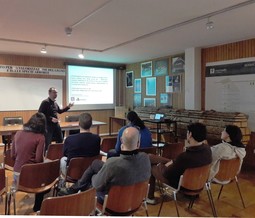
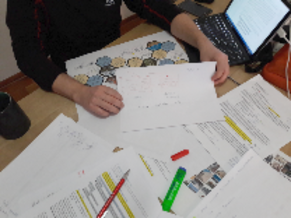
Photo Left: Marcin Brzezicki during the presentation at IVALSA at 24th of JAN, 2018
Photo Right: Typology concepts being elaborated and discussed during the working meeting
Rémi Curti
Rémi Curti, Ph.D. student at LaBoMaP (ENSAM Cluny), completed his Short-Term Scientific Mission with Dr. Giacomo Goli at GESAAF department of the University of Florence.
The objective of the STSM was to develop a post-processing strategy for experimental data acquired prior to the STSM during a visiting period of Dr. Goli at the ENSAM. The project wishes to develop a fast method to determine the specific cutting coefficients of anisotropic materials such as wood. In this experiment a reference sample and a sample of thermally modified poplar were machined. The final goal is to lead to optimization of the cutting parameters to design energy-efficient machining programs. In the present work the method was used to evaluate the impact of wood modification on the cutting forces.
The developed method of analysis has shown to work fine and to produce force patterns in line with expectations for an anisotropic material. Even if a first approach seem to be promising it requires now to be executed at a larger scale with a dedicated sampling to credit statistical significance to the conclusions. The samples were machined in the form of a wheel and the forces on the two axis measured by a 3-component piezoelectric dynamometer.
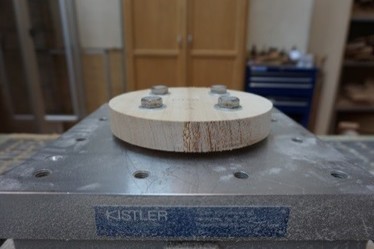
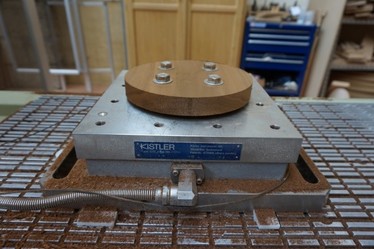
Photos: Solid poplar (left) and Heat Treated (right) poplar disks after machining fixed above the piezoelectric dynamometer to determine the cutting forces
Mikko Mäkelä
Mikko Mäkelä currently works as a post-doctoral researcher at Aalto University, the Department of Bioproducts and Biosystems. He completed his STSM at the Swedish University of Agricultural Sciences, the Department of Forest Biomaterials and Technology during December 4-8, 2017. The aim of the Short-Term Scientific Mission was to determine the spatial properties of acetylated wood at different moisture contents using hyperspectral near infrared (NIR) imaging and multivariate image analysis.
Acetylation is an industrially applied method to improve the biological durability, dimensional stability and sorption properties of wood. However, little information exists on the spatial differences of acetylated wood surfaces. Hyperspectral imaging records a spectrum in every single pixel of an image and can be used to determine the spatial properties of wood. Different images can be combined and the changes due to e.g. acetylation and sample storage can be compared based on an experimental design. Thus far our results illustrate significant differences in the acetylation of early and late wood based on image exploration and image regression on measured moisture content and weight percent gain values. Currently we acquiring more data to illustrate the mechanisms on the cell level. The STSM was highly useful in creating connections and new collaboration with wood scientists at Aalto University.
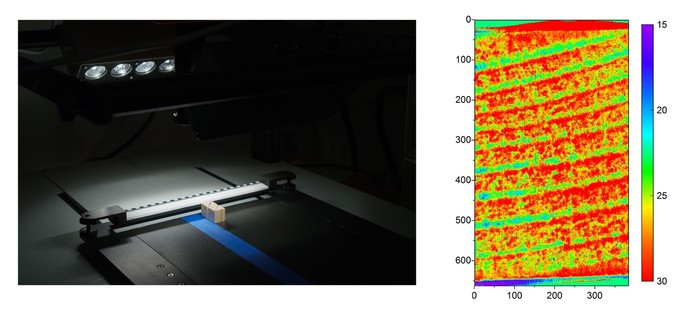
Images: Wood samples under the hyperspectral camera (left) and predicted moisture content of acetylated wood based on image regression (right).
Marta Petrillo
Marta Petrillo is a research assistant at the Trees and Timber Institute of the National Research Council (CNR-IVALSA) in San Michele all’Adige, Italy. She completed her short-term scientific mission (STSM) at the InnoRenew Centre of Excellence in Izola, Slovenia from 10.12.2017 to 17.12.2017. Her host supervisor was Prof. Andreja Kutnar and the title of the STSM was “Life cycle analysis of bio-based facades materials with a focus on in-service performance, maintenance requirements and end of service life”.
The overall goal of this STSM was to develop a method for a comparative assessment of a large dataset of bio-based facades materials, including chemically and thermally modified wood, impregnated wood, and other bio-based materials. The focus was specially directed on in-service performance, maintenance requirements, and end of service life options. The life cycle analysis (LCA) was performed using the SimaPro 8.0.2 software. The environmental impact was calculated testing several operations that are required in order to maintain and refurbish facades. Beside standard LCA calculation an original algorithm was developed, in order to compare different options for the end of service life from the point of view of material and energy rational use and protection of the environment."
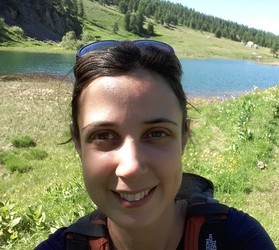
Báder Mátyás
As a PhD student and young researcher at the University of Sopron, Báder Mátyás completed a Short-Term Scientific Mission with Tim Koddenberg and Lukas Emmerich at the Georg-August-University of Göttingen. His host was Prof. Dr. Holger, Militz The aim of the research was to investigate the internal properties of combined hydrothermal and mechanically modified wood. Using the X-Ray micro-computed tomography (Nanotome), 3D images were made on untreated- and longitudinally compressed wood, without destructing the cells. The changes of the fiber lumen diameter and fiber length together with porosity were also measured.
With the dynamic vapor sorption (DVS) equipment the behavior of treated wood material in different air humidities was measured. This can be considered as a basic research, because about the sorption properties of longitudinally compressed wood material nothing is known yet. The results are promising, these investigations will also be appended to the doctoral thesis of Báder Mátyás.
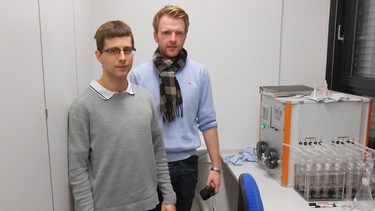
Photo: Mátyás Báder (Uni Sopron) and Lukas Emmerich (Uni Göttingen)
Jiří Kunecký
Dr. Jiří Kunecký from the Institute of Theoretical and Applied Mechanics, Czech Academy of Sciences visited the InnoRenew CoE in Izola, Slovenia under supervisors Dr. Matthew Schwarzkopf and Dr. Andreja Kutnar (19.10.-9.11.2018). The purpose of the stay was the study of the creep behavior of modified timber, especially using dynamic mechanical analysis (DMA). Nevertheless, due to an unexpected event - fire in the building - the DMA testing machine was inaccessible and the work had to be reorganized. It consisted finally of 1) testing of thermally modified and unmodified European beech samples using UTM and DIC Aramis, 2) numerical modeling of creep behavior using Prony series, 3) evaluation of results of pre-measured samples. All three parts had strong focus on description of thermally treated wood in different sample scales and under different strain rates. This is, however, a broad theme able to cover a few dissertations, but first steps have been made to study this highly nonlinear behavior.
Creep of thermally modified timber is only scarcely mentioned in literature and is very important for use of such a material in practice. The results show a different creep behavior of thermally modified timber when compared to the untreated one, however, might be related only to changes in density. To what extent, should be verified in the future. The STSM resulted in a ongoing collaboration in this field between the institutions and broadened not only the knowledge about creep and its numerical description but served also as a nice base for networking people having the same professional interest.
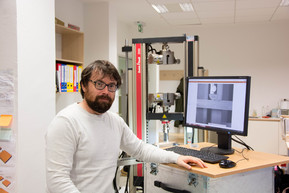



Photo Top Left: Dr. Jiří Kunecký in the lab
Photo Top Right: Setting up a test sample
Photo Bottom: Numerical modeling of creep behavior using Prony series
Kelly Peeters
Kelly Peeters is a researcher at the InnoRenew Center of Excellence in Izola, Slovenia. She completed her STSM at NIBIO in Ås (Norway) with Dr. Erik Larnøy as her host from 08.10.17 to 28.10.17. Together with Prof. Dr. Callum Hill, Kelly started with the development of a wood modification process based on a Maillard type of reaction with cheap, water-soluble, non-leachable and low molecular weight modification agents, using heat as a binding source.
They tested several combinations of sugars, amines, buffer and reaction catalysts on small pieces of beech and pine wood. The wood was soaked in the water based solutions for 24 hours, while vacuum was used to remove the air in the wood lumen. The samples were put in an oven for 2 days at 120°C. Leaching tests were performed afterwards in water. The size and weight of the oven-dried wood samples were determined before and after modification and after each leaching cycle.
After leaching the wood samples in water, bright colored solutions were obtained. Since the wood was impregnated with colorless to light yellow solutions we can conclude that the Maillard reaction occurred. Unfortunately, the high amount of leaching means that there are, or still high concentrations of unreacted material present, or the formed Maillard product is to a high extent soluble in water. After 3 leaching cycles we observed that we obtained only a small weight percent gain of the wood in comparison with the unmodified wood. Therefore, further research is needed to be able to bind the reaction products into the wood.
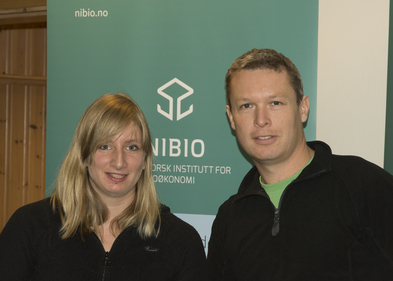
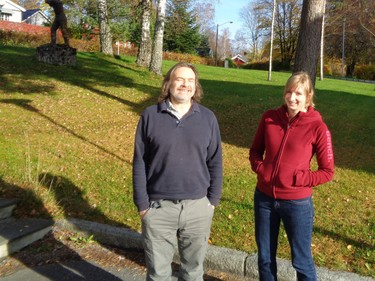
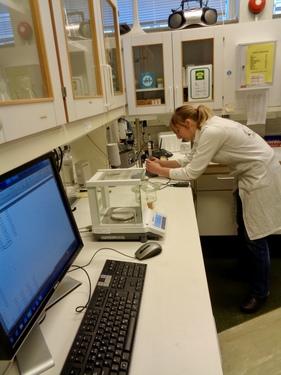
Photo Top Left: Kelly and Erik Larnøy
Photo Top Right: Kelly and Callum Hill
Photo Bottom: Kelly prepares samples in the laboratory
Kerstin Wagner
Kerstin Wagner is a Ph.D. student at Salzburg University of Applied Sciences at the faculty of Forest Products Technology and Timber Constructions. She completed her short term scientific mission at the Laboratory for Wood and Paper Chemistry at the Johan Gadolin Process Chemistry Centre at Åbo Akademi University from the 13.08.2017 till 1.09.2017. Her host supervisor was Prof. Stefan Willför. The title of STSM was “Characterization of Chemical Constituents of Various Condensate from different Wood Processing Processes".
Wood has the potential to reduce CO2 emissions and that potential can be increased through an increase in wood applications. For example, every year enormous amounts of sawn timber are modified, steamed or/and kiln dried and during these processes various compounds leave the wood as a by-product. Currently these products are not used and have no further application, thus they are lost.
The extractives as condensation products from the drying and modification process have interesting properties. To analyse these properties a STSM was completed. In the STSM the following wood species and method were used: larch, spruce and alder as well as Gas Chromatography– Mass Spectrometry (GC-MS), High Performance Size Exclusion Chromatography (HPSEC) and Solid Phase Micro Extraction (SPME). The resulted obtained by the (GC-MS) show that there are saccharides and acid in the condensation as well as resin compounds.
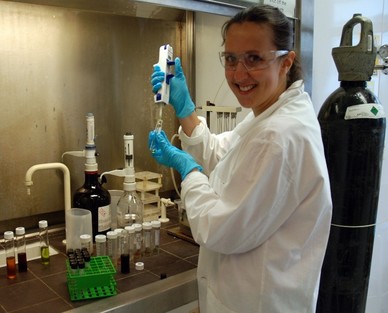
Photo: Kerstin prepares samples in the laboratory
Joanna Suida
Joanna Siuda is Ph.D. student at the Institute of Wood Chemical Technology at the Faculty of Wood Technology (Poznan University of Life Sciences). She successfully completed a Short Term Scientific Mission (STSM) at CNR-IVALSA in San Michele all'Adige, Italy, lasted from 26th of June to 6th of July 2017. Her host supervisor was Dr. Anna Sandak. The title of STSM was “Wood silanization through the catalysed reaction with alkoxysilanes - FT-IR studies”.
Chemical modification is one of the methods for improving wood properties. Modification with organosilicone compouds become more common in research and practice. The starting point of the research on chemical wood modification is an argument that wood chemical components contains reactive functional groups which are able to create new bonds with silicon compounds e.g. alkoxysilanes. The aim of the study was to identify interactions between selected alkoxysilanes and wood main components. The scope of the study covered wood samples modified with methyltrimethoxysilane (MTMOS) or methyltriethoksysilane (TEMS) in the presence of catalysts. The FT-NIR and FT-IR spectra clearly show interactions between alkoxysilanes and wood.
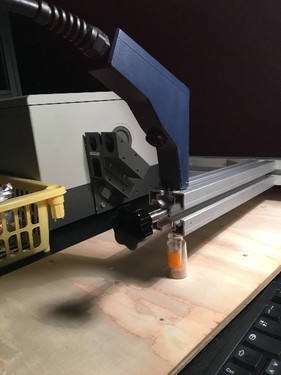
Photo: NIR analysis of wood samples
Bruno Esteves
Bruno Esteves, Adjunct Professor from Polytechnic Institute of Viseu-Portugal, Department of Wood Engineering, completed his STSM “Weather resistance of thermally modified wood” with Dr. Jalel Labidi, Chemical and Environmental Engineering Department University of the Basque Country, Spain. The main purpose of the STSM was to analyze untreated and heat treated extractives by GC-MS in the beginning and after weathering.
Untreated and heat treated pine (Pinus pinaster and Pinus radiata) samples were milled in a mill and then sieved, using the 40-60 mesh fraction for chemical analysis. The extractive content was determined by successive Soxhlet extraction with dichloromethane (DCM), ethanol, and water as solvents. Half of the extracted solution was submitted to chemical analysis and the other half was dried in an oven at 40ºC overnight, followed by 1 h drying at 100ºC. The percentage of extractives in each solvent was determined gravimetrically in relation to initial dry mass. Aliquots from the extracts were dried and derivatized with pyridine and BSTFA and kept in an oven at 60ºC for 20 min. Afterwards samples were injected in GC-MS and the resulting EI mass spectra were used for the identification of compounds by NIST08 mass spectra library.
The preliminary findings of this STSM showed that heat treatment increases the amount of extractives mainly those soluble in ethanol and water, although most of the original wood extractives disappear upon heat treatment, especially the most volatile compounds, while new extractives appear as degradation products of structural polymers.
During his visit, Prof Bruno Esteves has acquired valuable training about GC-MS analysis like preparation of the samples (Photo left), injection and also on the interpretation of the results.
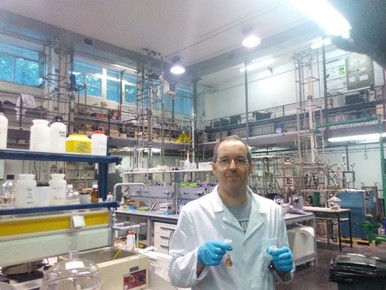
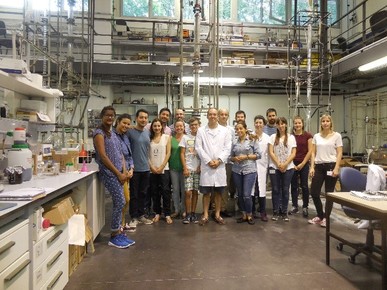
Photo Left: Preparing samples for GC-MS.
Photo Right: BIORP Team and Guest
Petr Čermák
Dr. Petr Čermák is working as a researcher at Faculty of Forestry and Wood technology, Department of Wood Science, Mendel University in Brno. He successfully completed a Short Term Scientific Mission (STSM) in the period from 19 June to 30 June 2017 at Department of Bioproducts and Biosystems at Aalto University, Finland. His host supervisor was prof. Lauri Rautkari.
The aim of present STSM project was to clarify influence of wood pre-treated by different substances (acetic acid, glycerol and ethylene glycol) on chemical reactions that might occur during high temperatures. Preliminary results could potentially lead to optimization and/or improvements of currently used thermal modification processes. This might further allow for thermal modification processes to occur more rapidly at lower temperatures and therefore improve the economic viability of process (lower energy use) and eventually reducing the risk of negative effects on wood properties (decrease in mechanical properties).
Scots pine (Pinus sylvestris L.) sapwood was used for present study. Specimens of dimensions were pre-impregnated by three different substance (acetic acid, glycerol, ethylene glycol) within two different concentrations. Afterwards, specimens were thermally modified at 160°C and 200°C in steam environment. During thermal modification process, temperature within center of specimens was measured in order to record influence of chemical substances on temperature increase. Weight percentage gain (WPG) was calculated after impregnation as well as mass loss after thermal modification. Moreover, the FTIR analysis was done for selected specimens in order to observe spectra for chemical substance (glycerol for instance) which may remain in wood after thermal modification.
First results shows significantly higher WPG was observed for specimens impregnated by glycerol (GL), i.e. 29% for 25% concentration and 55% for 50% concentration. Glycerol has much higher evaporation, resp. boiling point (approx. 290°C) when compared to other substances, therefore it seems to be more stable. Reference (non-pre-treated) specimens reached 2% ML at 160°C and 6% ML at 200°C. Slightly higher ML was reached for AA and EG pre-treated specimens, i.e. 2-4% at 160°C and 5-8% at 200°C. Significantly higher ML was found for GL specimens, especially at high temperature, i.e. up to 25%. It is assumed that glycerol already started to degrade at 200°C. From the first preliminary results its evident that pre-treated specimens behave differently when compared to reference, non-treated, wood. At the first phase the incensement in temperature was similar for all specimens, afterwards the heating was more rapid for pre-treated specimens. Required modification temperature (200°C) was reached almost 2 times faster for all pre-treated specimens, when compared to reference.
There seems to be some potential for glycerol pre-treatment, as its further affect moisture behaviour and may also accelerate temperature increase during TM process, but there is need more analyses to be done and more parameters to be evaluated. During his visit he has acquired valuable training about thermally modified wood, FTIR analysis and practical performance of pre-treated material by various chemical substances.
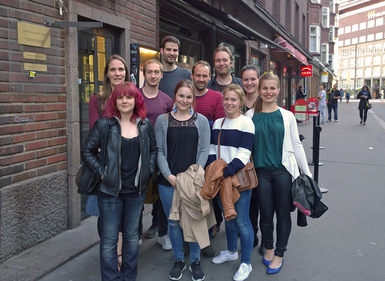

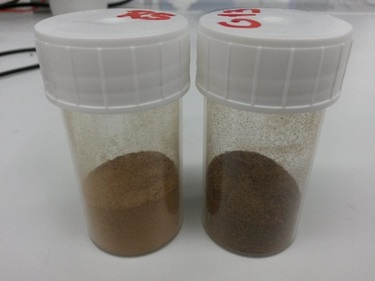
Photo Top: Prof. Lauri Rautkari research group
Photo Bottom Left: Specimens impregnated by various chemical substances (acetic acid, ethylene glycol, and glycerol)
Photo Bottom Right: Powdered specimens of glycerol, prepared for FTIR analysis
Second Grant Period (1 June 2016 - 30 April 2017)
Miguel Redón
Dr. Miguel Redón, Associate Professor from the Universitat Politecnica de Valencia, Department of Rural and Agrifood Engineering, completed his STSM “Analysis of fracture toughness in Mode II on Modified Wood” with Dr. Vaclav Sebera, Mendel University in Brno, Faculty of Forestry and Wood Technology, Department of Wood Science. The main purpose of the STSM was directed to provide fundamental data about fracture behavior of thermally modified wood in Mode II.
The testing of thermally modified beech wood at two different temperatures has been tested against reference non-treated samples. The test was based on 3-point bending end-notched setup in the mode II (Figure 1). Also, the measurement was accompanied by 3-D digital image correlation (DIC) providing additional data such as displacement and strains enabling the evaluation of the crack development (Figure 2b).
The preliminary findings of this STSM showed that the resistance curve of the non-treated wood samples is greater than the thermally modified specimens (Figure 2a). From that, it could be concluded that the strain energy release rate (GII) of thermally modified wood would be lower than the reference or non-treated wood which confirms that thermal modification influences fracture toughness properties of wood.
During his visit, he has acquired valuable training about thermally modified wood in addition to practical performance of fracture toughness that has been strengthened by using and interpreting non-contact mechanical measurement systems such as the DIC technique.
Fig 1. 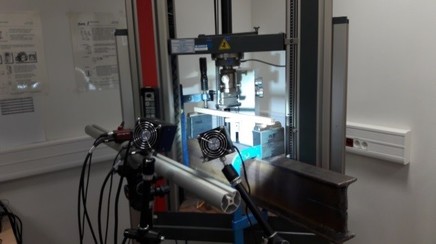
Fig 2a. 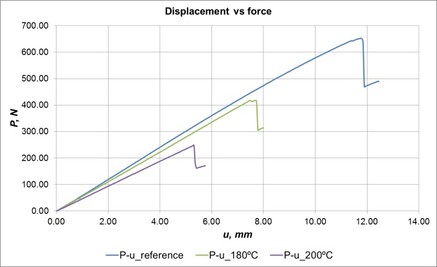
Fig 2b. 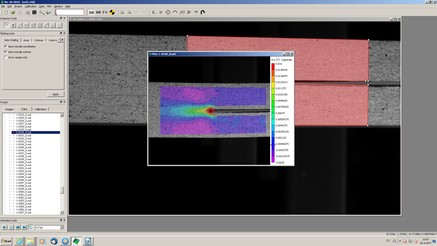
Gaye Kose Demirel
Gaye Kose Demirel is a Ph.D. student and working as a Research Assistant in the Discipline of Wood Protection, the Department of Forest Industry Engineering, at Karadeniz Technical University in Trabzon/ Turkey. She successfully completed a Short Term Scientific Mission (STSM) in the period from 26 May to 17 April 2017 at CNR-IVALSA Biodegradation and Preservation Laboratory in Florence, Italy. Her host supervisor was Dr. Sabrina PALANTI.
The title of STSM was “Usability of Epoxidized Vegetable Oils as a Wood Preservative and Its Effect on Leachability of Boron”. Epoxidizing vegetable oil in order to reactivate oils and improving the bonding ability between oil and wood components were targeted. Thus, less oil retention (80-270 kg/m3) was used. Additionally, in this study, leaching of boron compounds in wood were targeted to be stopped because boron compounds are the rare wood protection chemicals which are environmentally friendly and show both insecticide and fungicide character. One of key factors for understanding of modified wood with oils is the performance of treated wood with oils against biotic factors including insect and decay fungi. In this duration time in IVALSA, she initiated insect and decay test on previously impregnated pine samples according to standards of EN (113) and EN (47), respectively. Basically, 504 kolle flaks were prepared, and two types of fungi (Coriolus versicolor and Coniophora puteana) were inoculated into them. Finally, impregnated pine samples and control groups were placed into the kolla flaks. Beside decay test, the larvas of Hylotrupes bajulus were inserted into 220 impregnated pine samples, by inserting 6 larvas into each single pine samples for insect test.
The first results will be available after 12 weeks. She is very grateful to Dr. Sabrina PALANTI and CNR-IVALSA’s staff for completing this part of study in IVALSA. This work in the STSM will also contribute to the Ph.D. thesis of Gaye Kose Demirel
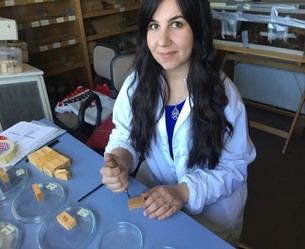
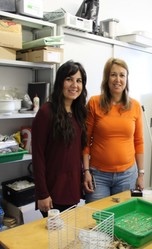
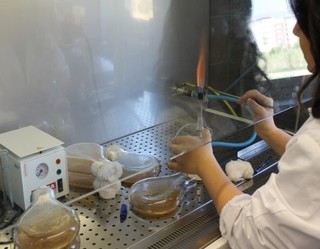
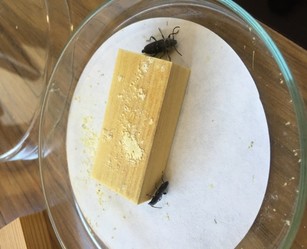
Photos upper left: Gaye Kose Demirel started sample preparation for insect test
Photos upper right: Dr. Sabrina Palanti and Gaye Kose Demirel during the STSM visit
Bottom left: Inoculating fungi
Bottom right: Hylotrupes bajulus
Jure Žigon
Jure Žigon, a PhD student of the interdisciplinary doctoral study programme of Biosciences at the Biotechnical Faculty (University of Ljubljana), successfully completed a short term scientific mission (STSM) in the frame of COST FP1407 project. Between 4th and 21st of February 2017, he was a guest at Clausthal University of Technology in Clausthal-Zellerfeld, Germany. His host supervisor Dr. rer. nat. Sebastian Dahle from Institute of Energy Research and Physical Technologies, gave him some basic training on wood plasma treatment.
The title of his STSM was “Enhancement of coatings for wooden claddings via plasma pre-treatments and environmental impact”. As a practical example for application in construction and exterior usage, Norway spruce (Picea abies (L.) Karst.) wood coated with water-based two-step acrylic lacquer stain was used in the present research. Prior to application of coatings, wood was treated with dielectric barrier discharge (DBD) plasma treatment technique in air at atmospheric pressure. Plasma pre-treatment process was optimized, considering the hydrophilization and the best wettability of substrate after application of different liquids. Furthermore, morphological and chemical properties of untreated and plasma treated surfaces were studied, using ATR-FTIR and CLSM technique. Finally, mechanical properties of coating systems were evaluated with standard pull-off strength and cross cut tests. Environmental impact of substrate preparation using plasma treatment was evaluated basic on energy consumption. It was shown that DBD plasma treatment evidently increase wettability of wood. Mechanical properties of coatings were improved with additional plasma pre-treatment of the substrate. Plasma treatment is environmentally friendly technique, without energy-intensive drying processes or chemical waste.
Experimental work and results conducted during this STSM present a good foundation for future work on his PhD.
Fig 1 
Fig 2 
Fig 3 
Fig 4 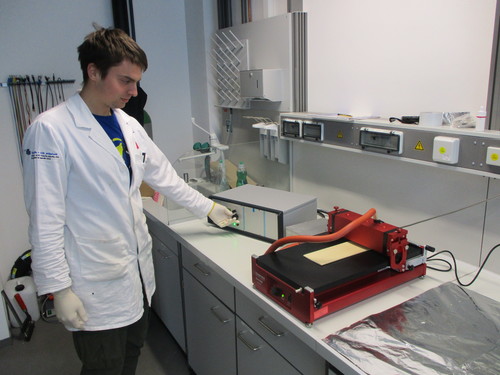
Figure 1: Created plasma between ceramic barrier and samples surface
Figure 2: Time-dependent evolutions of red and green-coloured water droplets areas on different plasma treated surfaces
Figure 3: 3D profile of the sample surface segment before (left) and after (right) plasma treatment
Figure 4: Jure Žigon completing experimental work in Clausthal University of Technology, Institute of Energy Research and Physical Technologies
Ivan Sopushynskyy
Ivan Sopushynskyy working Prof., Dr. hab. at the Ukrainian National Forestry University completed the Short Term Scientific Mission in the period from 10.03. till 20.03.2017 at the Department of Wood Biology and Wood Products of Georg-August-University in Göttingen, Germany. The main purpose of the STSM was directed to study engineering properties of Laminated veneer lumber (LVL) products and their quality control as well as the relationship between wood modification processing, product properties, and the associated environmental impacts.
LVL products are of great structural use due to their high engineering properties dealing with the testing on the mechanical properties like tension, shear, compression etc. The precise sorting on quality includes (a) pre-sanding for perfect quality control, (b) pre-grading for less waste, (c) more efficient machining cycles for lower labour costs and (d) fixed widths on request. The quality control of LVL is directed to check technical properties (density, strength and stiffness values) for every application of boards and beams. Germany has the most specific national legislation on the management of waste wood 'Ordinance on the Management of Waste Wood'.
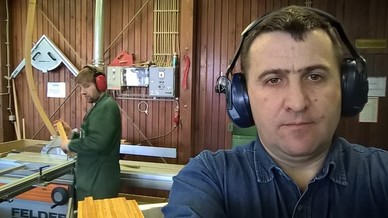
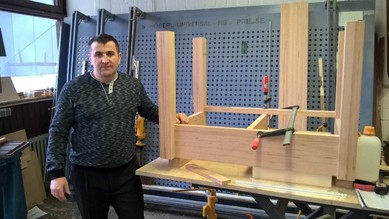

Photos from left to right: Vladimir and Ivan preparing the samples for testing; LVL products produced at the Department of Wood Biology and Wood Products of Georg-August-University.
Anna Sandak
Dr Anna Sandak, researcher from CNR-IVALSA completed her STSM “Alternative trials for end-of-life bio-materials transformation” with Dr Magdalena Kutnik (FCBA, Bordeaux, France).
Construction and demolition sector generate one of the highest volumes of waste in Europe. Extensive research is conducted nowadays to promote cascade use of resources, their reuse and recycling. Bio-based building materials are considered as interesting alternative in modern building manufacturing. However, it must be demonstrated that they are significantly more favourable than the corresponding mineral and fossil-based alternatives. This STSM was focused on laboratory and in-field tests with selected fungi and insects used for bio-based building material transformation. It was expected, that certain organisms will speed-up degradation process of investigated building materials.
Experimental samples (112 bio-based facades materials) were cut into thin strips (150x20x5mm) on the circular saw and calibrated to 5mm thickness on the sanding machine. From each material several specimens were prepared and used for following experiments: in-filed degradation in three different locations: FCBA (Oléron island, France), La Rose test site - Guadeloupe Island (Goyave, Antilles, France) IVALSA (San Michele, Italy), laboratory test with termites and microbiological tests in two types of soil (FCBA, Bordeaux, France).
First results demonstrated difference in degradation speed and proved termites preferences regarding selected biomaterials. All experimental tests provided encouraging results and thank to availability of the FCBA staff the experiments will be carried on for the next 12 weeks.
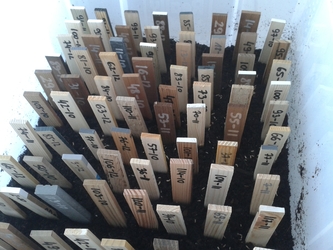

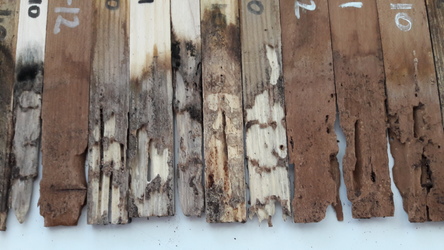
Photos: Upper left - Start of test; Upper right - Termites in action; Bottom - Samples after 3 months of termite exposure
Mohamed Tahar Elaieb
Dr. Mohamed Tahar Elaieb, researcher from the Tunisian National Research Institute of Rural Engineering, Water and Forests (INRGREF), Laboratory of Management and Valorization of Forest Resources (LGVRF), is hosted by Kevin Candelier, CIRAD_ UR BioWooEB, Montpellier (FR).
This STSM is focused on the “Understanding of the effect of natural salt water treatment on durability, fiber densification and chemical modification of palm wood”. The main goals of this work is to evaluate and understand the durability improvement of Palm wood after undergone an ancestral preservative treatment by saltwater immersion in the Lake Jerid (ChotDjérid), in Southern Tunisia. The treatment consists in removing of the freshly felled palm trunk for a period of 1 to 2 years (depending on species) in the Lake. After this stay, the material changes its appearance, color, properties and becomes a dense, durable and resistant material. This natural treatment is long gone and the treatment process of this wood remains unclear. So, the STSM work is to determine the main properties of this local species with many advantages: intrinsic characteristics of palm stems and their variability (anatomy, chemical composition, physical properties, mechanical properties, natural durability, etc.), in order to understand the wood material modification process and to in order to know the feasibility of implementing this modification method in the Tunisian market, with optimized industrial processes and to obtain possible finished Palm wood products. The materials and methods to achieve the goals of this Short Term Scientific Mission were supported, supplied and monitored by the research group of BioWooeb of the CIRAD Laboratory (Photo 1). During my visit, I was formed on wood decay and termite resistance tests according to European standards (Photo 2-3), wood chemical and mineral compositions analyses by MP-AES (Microwave Plasma-Atomic Emission Spectrometer).
Link: http://ur-biowooeb.cirad.fr/actualites/accueil-mohamed-tahar-elaieb
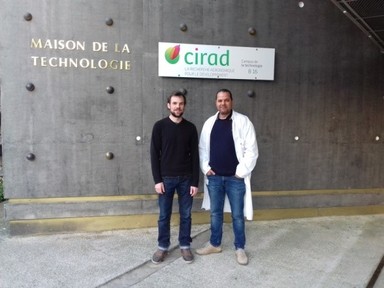
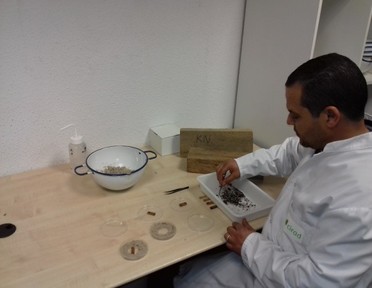

Photos: Upper Left (1) - Mohamed TaharElaib and Kévin Candelier during the STSM visit. Photo credit - Sébastien Paradis.
Upper Right (2) - Preparation of termite resistance screening tests. Photo credit - Kévin Candelier
Bottom (3) - Preparation of fungal resistance screening tests. Photo credit - Kévin Candelier
Lars Tellnes
Lars Tellnes, researcher at Norwegian Institute of Wood Technology completed a STSM with Dr. Sc., Christelle Ganne-Chédeville of Bern University of Applied Science, Institute of Material and Wood Technology. The purpose of the visit was to complete a review of biogenic carbon accounting methods for calculating climate change impacts in life cycle assessment (LCA). The output of the STSM was a manuscript that was submitted to the FP1407 special issue in iForest, which was also co-written by Ana Dias, Franz Dolezal, Callum Hill and Edwin Zea Escamilla.
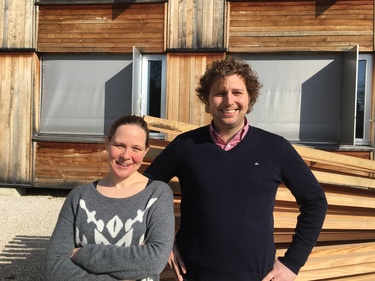
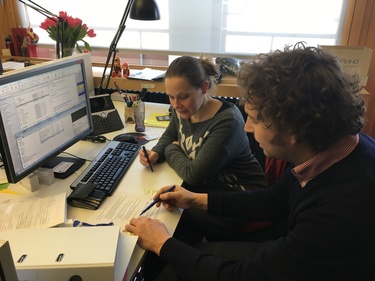
Photos: Lars Tellnes and Christelle Ganne-Chédeville during the STSM visit
René Herrera
René Herrera, PhD student from the University of the Basque Country UPV-EHU, Chemical and Environmental Engineering Department, has completed a short-term scientific mission at the University of Bío-Bío in Concepción, Chile. The title of his STSM was “Thermal modification of radiata pine wood grown in Chile”.
The main goals of this STSM were to thermally modify radiate pine wood of different quality at pilot scale, and to measure several physical-mechanical properties of wood after modification in order to know the feasibility of implementing this modification method in the Chilean market, and to obtain possible finished wood products.
The materials and methods to achieve the goals of this Short Term Scientific Mission were supported, supplied and monitored by the research group of Wood Drying and Thermal Treatments of the University of Bío-Bío in cooperation with their industrial partners of ‘Bioforest’ research group from Arauco Company (Chile).
During his visit, the applicant acquired training about wood drying methods and the parameters taken into account during the thermal modification in addition to preparation of loads, measurement of physical properties in large samples and discussion of the results.
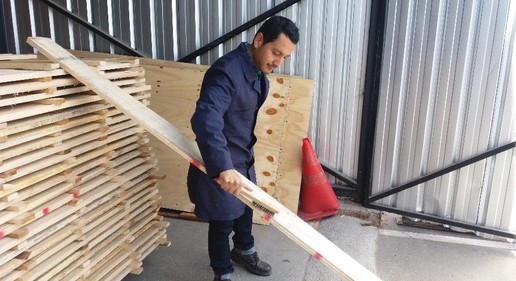
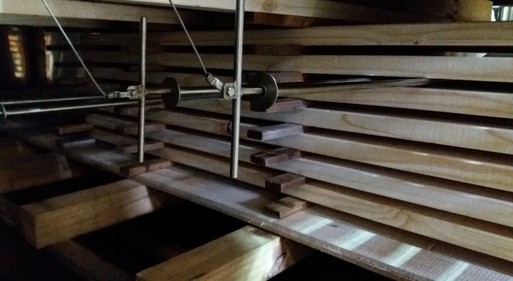

Photos: Upper Left- René preparing samples before TM; Right- Load inside the pilot Kiln; Bottom- Measurement of properties after TM.
Dennis Jones
Dr. Dennis Jones undertook a short-term scientific mission to Slovenia, which linked visits to both the Biotechnical Faculty, University of Ljubljana, and the Andrej Marušič Institute, University of Primorska (host) in September 2016. The mission, under the title “The development and evaluation of a possible combined thermal/chemical wood modification” aimed to look at the use of a pre-treatment prior to thermal modification. The concept of the work was that the use of the chemical pre-treatment would help bind hemicellulose fragments usually volatalised during the thermal modification process. The combination of methods should also allow for reduced temperature during the thermal process. During the two week stay several series of Norway spruce and beech were treated and thermally modified. Work continues to analyse the results from this work, along with determination of the energy requirements, as part of an LCA inventory into the processes involved. Part of the work included the development of a total energy use method for the thermal modification phase.
Work continues to finalise the results from this work, and to identify if beneficial effects resulted from the combined treatment. In addition, discussions were held with both universities into further expansion of the work in this STSM, which will be considered for future collaborative work and publications.
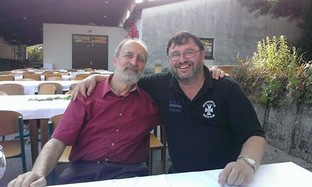
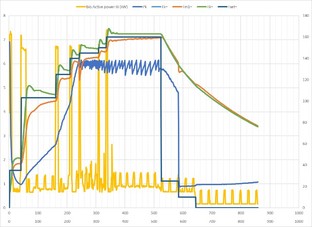
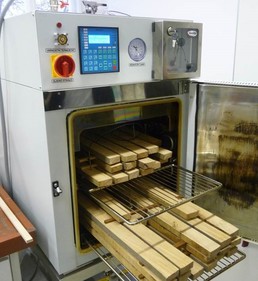
Photos: Upper left - Dennis Jones with Prof. Franc Pohleven (university of Ljubljana). Upper right - total energy use graph for the thermal modification process. Bottom - Norway spruce samples about to undergo thermal modification.
Báder Mátyás
As a PhD student at the University of West Hungary, Sopron, Báder Mátyás completed a STSM with Dr. Johannes Konnerth at the University of Natural Resources and Life Sciences, Vienna (BOKU). The aim of the research was the investigating of the induced changes of the wood cell wall in terms of mechanical properties of combined hydrothermal and mechanically modified wood.
Analyzing of the micromechanical properties of the longitudinally compressed wood samples proposed by means of nanoindentation (NI) in Vienna, Austria and investigated the morphological and structural changes also on the sub-micrometer level by means of advanced atomic force microscopy (AFM) in Tulln, Austria. The earlier examined macromechanical changes (Báder and Németh 2017, in press) indicated some changes in the microstructure, and with the help of this short term scientific mission the above featured investigations could made. The results are promising, now many micromechanical data known about this modified wood material. These investigations will also be appended to the doctoral thesis of the applicant.

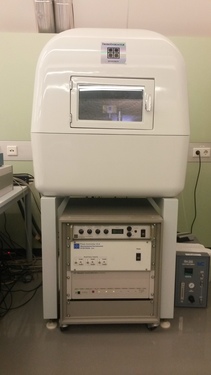
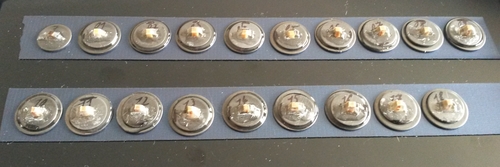
Photos: Báder Mátyás, Nanoindenter (top left and right) and the examined samples (bottom)
Matthew Schwarzkopf
Dr. Matthew Schwarzkopf traveled to the Norwegian Institute of Bioeconomy Research (NIBIO) located in Ås, Norway as part of a short term scientific mission (STSM) funded through the COST Action FP1407. The title of Schwarzkopf’s STSM was “Chemically modified lampante oil as a wood preservation treatment”. The objective of the STSM was to develop a wood preservative treatment methodology using previously prepared modified lampante oil.
During his week-long visit, Dr. Andreas Treu and others at NIBIO shared wood preservation expertise with Schwarzkopf and helped produce treated test specimens for further investigations into the preservative efficacy against fungal degradation, weathering, and leaching. In addition to just preparing treated test specimens, this STSM strengthened the University of Primorska’s collaboration with NIBIO for future work together.
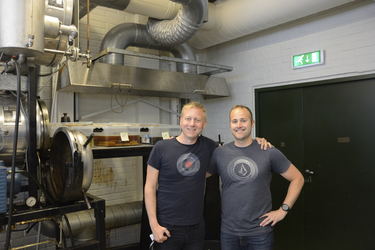
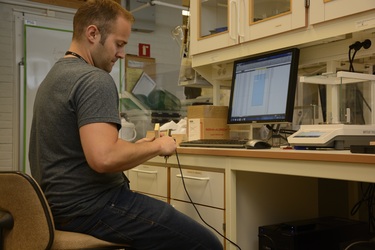

Photos from left to right: Dr. Andreas Treu and Dr. Matthew Schwarzkopf during the STSM to NIBIO; Dr. Matthew Schwarzkopf testing wood samples; and wood samples treated with chemically modified lampante oil (left) and untreated wood samples (right).
First Grant Period (1 June 2015 - 30 April 2016)
Manja Kitek Kuzman
Assit. Prof.dr. Manja Kitek Kuzman, University of Ljubljana, Department of Wood Science and Technology spent a short-term scientific mission » Modified wood - types and application in wooden construction (architecture) and their service life « at the host institution, Luleå University of technology, Wood Science and Engineering, Sweden.
The most important aspects of choosing wood as a building material were defined between northern and southern Europe and traces the changes in architecture through various traditions. The representative constructions were visited in Skeleftea and Waxo. For every construction key figures were gathered.
During the STSM a list of selected wood modification processes and resultant products used in wooden construction was prepared. Modified wood products were categorized by producer, country, method, products, ecolabels and certificates: chain of custody/eco labels and EPDs, quality certification and other /awards. The collection of data will be important background information for e.g. further LCA analysis of processes and products. Wood is an option, a piece in the puzzle towards developing sustainable community building.
The subject of this research is directly applicable to the research interests of the COST Action FP1407. The proposed STSM will enable a foundation for international partnership of the universities involved in the proposed STSM in future joint proposals for European grants.
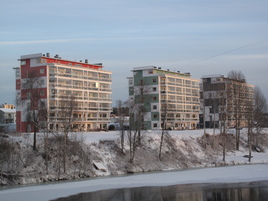
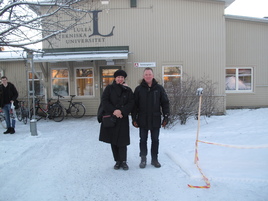
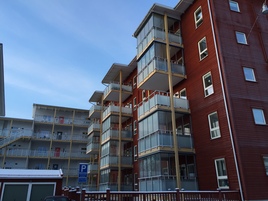
Photos from left to right: Älvsbacka Strand Cycle and Pedestrian Bridge in Skellefteå; Manja Kuzman and Dick Sandberg at Luleå University of technology, Wood Science and Engineering; and Multi-residence buildings, Ekorren District in Skellefteå.
Pavlo Bekhta
Prof. Pavlo Bekhta of the Ukrainian National Forestry University, Department of Wood-Based Composites, Cellulose and Paper, completed a short-term scientific mission at Poznan University of Life Sciences, Department of Wood Based Materials, Division of Gluing and Finishing of Wood.
The preliminary findings of this STSM showed that using of thermally densified veneer in coating process makes it possible not only to improve the aesthetic properties of the surface (smoothness and gloss) and adhesive strength between coating and substrate, but also to reduce the coat consumption. In addition, a significant reduction of varnish consumption reduces the emission of harmful substances into the environment and further facilitates the recycling of such coated products. Consequently, the use of thermally densified veneer in coating processes in addition to economic advantages will also have environmental benefits.
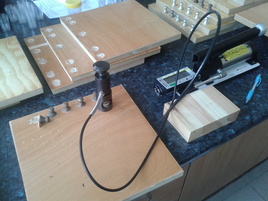

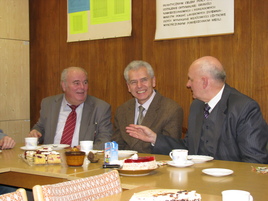
Photos from left to right: DeFelsko PosiTest Pull-off Adhesion Tester for determining of the adherence of lacquer coatings; Research team (from left to right: prof. Bekhta P., Dr. Lis B., Dr. Krystofiak T., prof. Proszyk S., Ing. Wilczyńska G.); Meeting with supervisor - Results analysis and discussion - Official farewell (from left to right: prof. Hruzik G., prof. Bekhta P., prof. Proszyk S.)
Jussi Ruponen
Jussi Ruponen, M.Sc. (Tech.), a Doctoral student, at Aalto University School of Chemical Technology Department of Forest Products Technology in Aalto, Finland, completed a short-term scientific mission at Mendel University in Brno, Brno, Czech Republic.
The STSM enabled learning to use a new thermal modification process control system, deepened the understanding of the relationship of wood shape stability and temperature gradient, and finally allowed to complete an LCA with some actual, self-collected data.
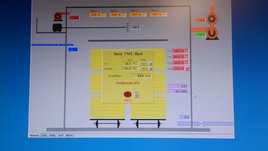

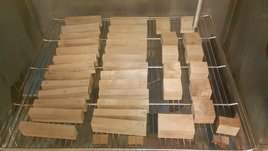
Photos from left to right: The process scheme, a set before modification; and a set after modification
Dr. Roman Shchupakivskyy
Dr. Roman Shchupakivskyy from the Ukrainian National Forestry University, Faculty of Woodworking Technologies and Design completed a 3 week short term scientific mission at the University for Sustainable Development Eberswalde, Faculty of Wood Engineering in Eberswalde, Germany.
The main goal of this mission was to document the LCI of thermally treated cladding production from incoming Ash boards, LCI data collection due to the thermal modification. In particular estimation of heat energy, water, raw material and N2 consumption due to thermal modification were investigated and, thereafter, allocated environmental outputs for manufacturing thermally modified Ash cladding were estimated. Some data was received about the possibility of reusing this material as a construction and outline ways of EOL scenario.
Several results have been found as the outcome of conducted LCI. The firs one is the high use of electricity as heat energy source in the process. It is the major source of CO2 contributing to global warming impact. Decisive influence also has the use of kiln dried sawn timber as the raw material. The influence of other factors (N2, water, etc.) is negligible for total emissions. Based on the obtained results of mechanical tests it can be concluded that used during 8 months cladding is absolutely suitable for recycling or reusing. For a more complete assessment of reusing ways should be conducted study on LCA at different EOL scenarios.
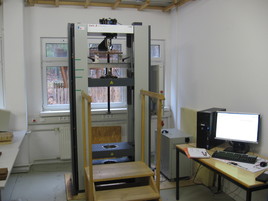
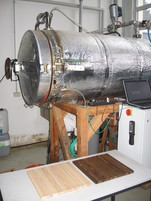
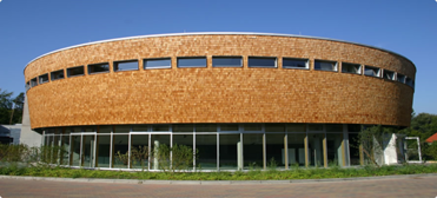
Photos from left to right: 3-point bend testing equipment; TM testing equipment with wood specimens; the lab building on Wald Campus.
Tinh Sjökvist
Tinh Sjökvist (Linnaeus University, Sweden) completed a STSM with professor Marko Petric (University of Ljubljana Biotechnical Faculty, Dept. of Wood Science & Technology) in Slovenia to learn measurement techniques on wood coatings.
Tinh is studying the adhesion force of a coating between thermally modified and unmodified spruce with different characteristics like fast grown, slow grown, sapwood and heartwood. We look forward to the results!
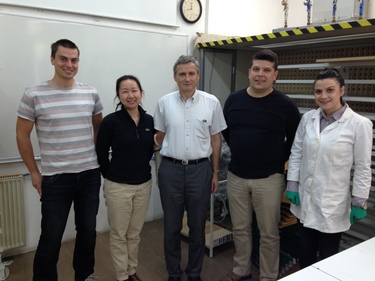
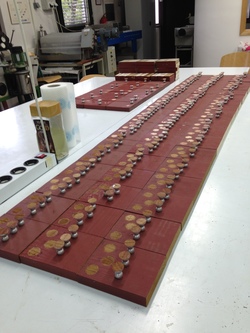
Photos from left to right: Tinh and STSM coworkers at University of Ljubljana Biotechnical Faculty, Dept. of Wood Science & Technology; wood samples.
Ben Mlouka
Selim Ben Mlouka, phd student from Aalto University, had a great experience on his STSM at Georg-August-Universität in Göttingen with Michael Altgen and Maximilian Wentzel. He researched the modification of wood in a reactor and extraction.
Selim also had the chance to listen to an excellent presentation made by Callum Hill.
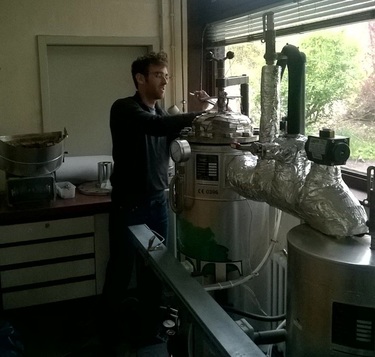
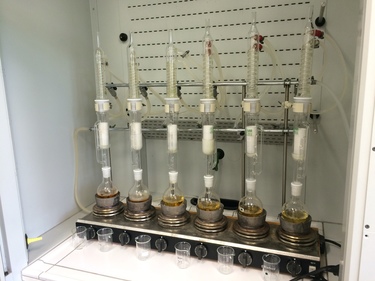
Photos from left to right: Ben working in the lab at Georg-August-Universität in Göttingen; sample setup.
Carolina Griebeler
Carolina Griebeler, a PhD student at University of Lleida (Spain), completed a short-term scientific mission at the Fachhochschule Salzburg (Salzburg University of Applied Sciences) at the Kuchl campus under the supervision of Gianluca Tondi and Thomas Schnabel.
Carolina studied the physical properties of thermally modified Eucalyptus saligna from New Zealand and the effects of one year of natural weathering on color stability and surface cracking of thermally modified Eucalyptus globulus from Spain.
She had a great experience in Kuchl, and this opportunity was important for her research.
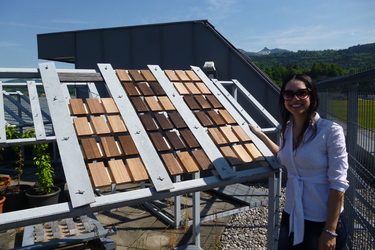
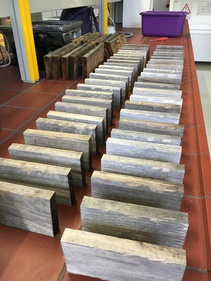
Photos from left to right: Carolina and Eucalyptus globulus samples on the first day the samples were set up on the rooftop of the university building for the weathering experiment; Eucalyptus globulus samples after one year of weathering on the rooftop.
Benedikt Neyses
Benedikt Neyses (Luleå Tekniska Universitet, Skellefteå) completed a STSM at Aalto University (Finland) with Lauri Rautkari. He impregnated solid wood samples with sodium silicates before they are densified and evaluating performance of surface densified wood.
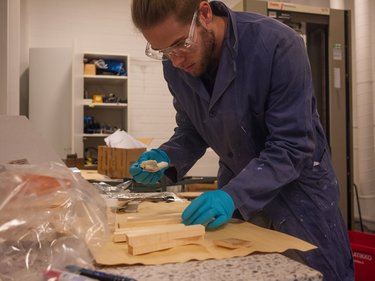
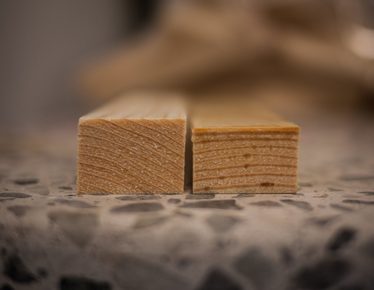
Photos from left to right: Benedikt prepares samples for experiments; Normal and densified wood samples.
Luke Beesley
Luke Beesley, soil scientist at The James Hutton Institute (Aberdeen, UK), completed a 7 day STSM entitled ‘Leaching of metal[loid]s from CCA-derived wood ash; a column experiment to examine Cr speciation’ at Czech University of Life Sciences (Prague, Czech Republic) in April 2016.
The mission’s main aims were to: 1) to determine bulk leaching of water-soluble arsenic (As) and chromium (Cr) from wood ash derived from the combustion of CCA (copper-chromate-arsenate; a preservative compound) modified waste wood, 2) with particular attention to the speciation of Cr, determining the evolution of Cr (IV) versus Cr (III) during the course of a column leaching test. This was completed using an advanced semi-automated micro-column leaching system where 10g of ash was subjected to a 2000 min-1 continuous leaching procedure designed to exhaust the water-soluble fraction of Cr and As, as well as other elements, in the ash, and hence provide detailed leaching curves for these elements approximating a period of environmental exposure of the ash.
The column procedure was successfully completed and, after sample preparation, analysis of the leachate samples for Cr and As was carried out, along with pH, dissolved organic carbon and other trace elements present in the ash, such as calcium, magnesium etc. The results reveal that the majority of the water-soluble pool of both Cr (82%) and As (65%), extracted during the whole test duration, was removed from the ash within the first 100 min-1; that corresponds to approximately 1% of the total amount of Cr and As in the ash, as previously determined by aqua-regia digestion. Thereafter 100 min-1 Cr removal plateaued whereas As continued to be extracted in a linear fashion up to, and presumably beyond 2000 min-1. These results confirm the rapid loss (solubilisation) of potentially toxic elements from the ash, which could become mobile within the environment. The test also confirmed the rapid pH decrease in the ash upon leaching, which also influences the fate of metals and metalloids variously.
The next stages of the data analysis will 1) perform geochemical speciation modelling on all of the derived data to determine the species of Cr and As which influences their potential toxicity within the environment and 2) examine the mixing of bio-sorbents with the ash to limit the solubility of potentially toxic elements. This will be done by continued collaborations between The James Hutton Institute and Czech University of Life Sciences, Prague”
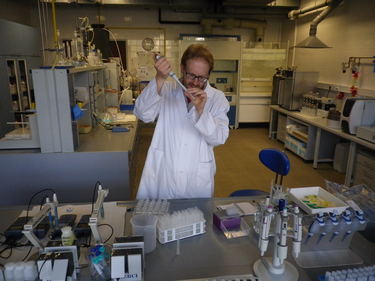

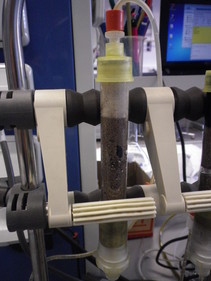
Photos from left to right: Luke preparing the samples for analysis; complete column-leaching set-up in operation; and the micro-column containing ash.
Graham Ormondroyd
Dr. Graham Ormondroyd of the BioComposites Center, University of Bangor, performed a weeklong STSM at division Forest and Forest Resources, department Wood Technology, Norwegian Institiute of Bioeconomy Research (NIBIO). Dr. Ormondroyd performed DNA quantification on Postia placenta decayed softwood samples for studying initial brown rot decay. The result from the testing at NIBIO will be compared with Dynamical Mechanical Testing on matched samples.
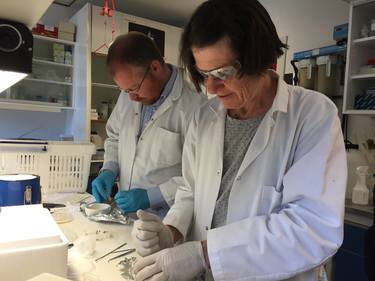
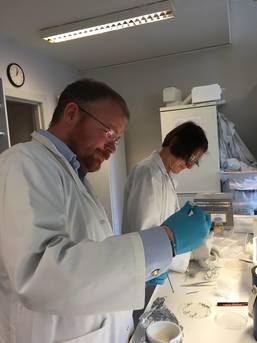
Photos from left to right: Graham and colleague in the lab seek to assess the effects of very early onset decay on the dynamic modulus of Norway spruce
Diego Penaloza
Diego Peñaloza Corredor, a PhD Student (Researcher) at SP – Swedish Technical Research Institute & KTH Royal Institute of Technology (Stockholm, Sweden) completed a STSM at the University of Primorska (Koper, Slovenia) under the direction of Assoc. Prof. Dr. Andreja Kutnar. The applicant is also part of the research project EnWoBio (Engineered Wood and Biobased Building Materials Laboratory, whose aim is to produce new knowledge that will contribute to the development of production, use and further refining of renewable forest or agricultural biomass.
The purpose of the STSM was to collect in situ the data necessary to carry out he LCA of the wax-treated windows that are the study subject of the Wintherwax project, and to complete this data with the data collected by the host institution in a previous similar project. Moreover, the work carried under the STSM and the Wintherwax project will be incorporated in one of the scientific publications appended to the doctoral thesis of the applicant, where the environmental effects from using selected novel biobased materials in finishing and small components (windows, flooring, cabinets, etc.) will be evaluated at the building level using LCA.
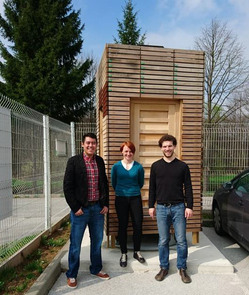
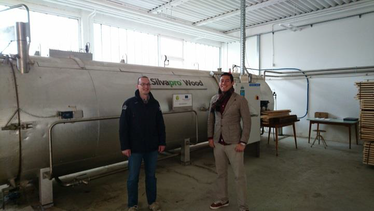
Photos from the visit to the manufacturing sites of MSora (left) and Silvaprodukt (right).
Tianran Ding
Tianran Ding of Wood Material Science, University of Eastern Finland, Joensuu, Finland completed a STSM with Dr. Sc., Christelle Ganne-Ghédeville of Bern University of Applied Science, Institute for Material and Wood Technology. Tianran acquired firsthand experience of tannin extraction and related data and corresponding LCA model establishment.
The purposes of wood this STSM are to learn tannin extraction technique, analyze yield and composition based on different operating conditions, possible tannin utilization and learning LCA model of tannin as adhesive for particleboard, conduct LCA on tannin extraction at different conditions, and find out the most environmental friendly process.
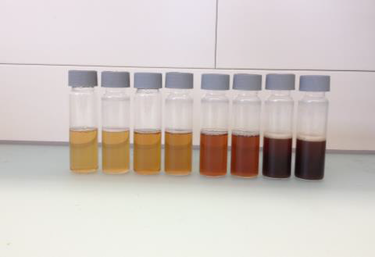
Photos. Left: Traditional hot-water extractives collected from each step (1st, 2nd, 3rd, 4th from right to left).
Right: Adding one step of cold-water extractives collected from each step (1st, 2nd, 3rd, 4th from right to left)
Tiina Vainio-Kaila
Tiina Vainio-Kaila, a Doctoral student at Aalto University completed a STSM with Dr. Martin Ohlmeyer, at Thünen Institut in Hamburg, Germany. This short term scientific mission aimed for analyzing the amount and quality of volatile organic compounds (VOC) of pine heartwood and sapwood and spruce heartwood and sapwood. Besides these also two separate substances, α-pinene and limonene were studied, since they are both very common terpenes. It is part of my studies on the antibacterial properties of wood VOCs.
It has been previously found out that wood surfaces of some wood species are antibacterial (Milling & al., 2005, Vainio-Kaila & al., 2013) and the purpose of the ongoing study was to further analyze if also the volatile components from wood could have some antibacterial effect. Analyzing the emissions from wood used in the microbiological trials is essential for the understanding and analyzing the results. Besides the suitable equipment the wide knowledge and experience on this field in Thünen institute were important for accomplishing this this project successfully. The microbiological trials were done earlier and the results are very promising.
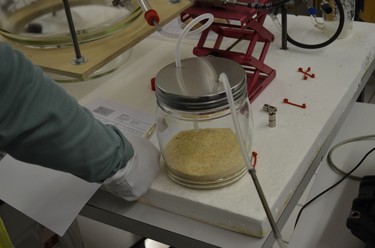
Photo: Glass container with wood dust and the sampling tubes. In the back is the clean air supply tube and in the front is the tenax tube attached to container. The other end of tenax tube is attached to a pump.
Follow @ModWoodLife
